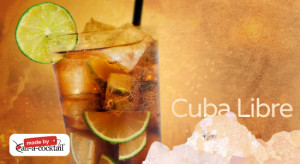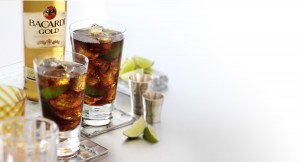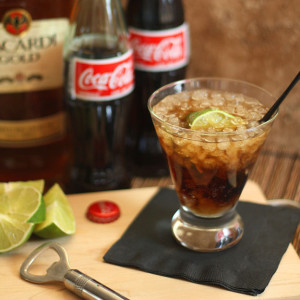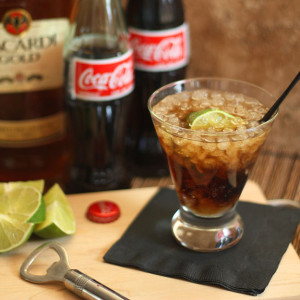The Cuba Libre (Spanish pronunciation: [ˈkuβa ˈliβɾe], English: /ˈkjuːbə ˈliːbreɪ/, “Free Cuba”) is a highball made of cola, lime, and white rum. This highball is often referred to as a Rum and Coke in the United States and Canada, where the lime juice is optional.
Accounts of the invention of the Cuba Libre vary. One account claims that the drink (Spanish for Free Cuba) was invented in Havana, Cuba around 1901/1902. Patriots aiding Cuba during the Spanish-American War — and, later, expatriates avoiding Prohibition — regularly mixed rum and cola as a highball and a toast to this West Indies island.
The world’s second most popular drink was born in a collision between the United States and Spain. It happened during the Spanish-American War at the turn of the century when Teddy Roosevelt, the Rough Riders, and Americans in large numbers arrived in Cuba. One afternoon, a group of off-duty soldiers from the U.S. Signal Corps were gathered in a bar in Old Havana. Fausto Rodriguez, a young messenger, later recalled that Captain Russell came in and ordered Bacardi (Gold) rum and Coca-Cola on ice with a wedge of lime. The captain drank the concoction with such pleasure that it sparked the interest of the soldiers around him. They had the bartender prepare a round of the captain’s drink for them. The Bacardi rum and Coke was an instant hit. As it does to this day, the drink united the crowd in a spirit of fun and good fellowship. When they ordered another round, one soldier suggested that they toast ¡Por Cuba Libre! in celebration of the newly freed Cuba. The captain raised his glass and sang out the battle cry that had inspired Cuba’s victorious soldiers in the War of Independence.
However, there are some problems with Bacardi’s account, as the Spanish-American war was fought in 1898, Cuba’s liberation was in 1898, and the Rough Riders left Cuba in September 1898, but Coca-Cola was not available in Cuba until 1900. According to a 1965 deposition by Fausto Rodriguez, the Cuba Libre was first mixed at a Cuban bar in August 1900 by a member of the U.S. Signal Corps, referred to as “John Doe”.
Along with the Mojito and the Daiquiri, the Cuba Libre shares the mystery of its exact origin. The only certainty is that this cocktail was first sipped in Cuba. The year? 1900. 1900 is generally said to be the year that cola first came to Cuba, introduced to the island by American troops. But “Cuba Libre!” was the battle cry of the Cuba Liberation Army during the war of independence that ended in 1898.
Popularity
This drink was once viewed as exotic, with its dark syrup, made (at that time) from cola nuts and coca.
Soon enough, as Charles H. Baker, Jr. points out in his Gentlemen’s Companion of 1934, the Cuba Libre “caught on everywhere throughout the [American] South … filtered through the North and West,” aided by the ample supply of its ingredients. In The American Language, 1921, H.L. Mencken writes of an early variation of the drink: “The troglodytes of western South Carolina coined ‘jump stiddy’ for a mixture of Coca-Cola and denatured alcohol (usually drawn from automobile radiators); connoisseurs reputedly preferred the taste of what had been aged in Model-T Fords.”
The drink gained further popularity in the United States after the Andrews Sisters recorded a song (in 1945) named after the drink’s ingredients, “Rum and Coca-Cola”. Cola and rum were both cheap at the time and this also contributed to the widespread popularity of the concoction.
The drink’s name has evolved somewhat in both Cuba and the United States, where some choose to refer to it as a Mentirita (“a little lie”), in an opinionated reference to Cuban politics.
Agencies/Wiki/ Internet Photos/ YouTube/Arnoldo Varona/TheCubanHistory.com
THE CUBAN HISTORY, HOLLYWOOD.
FOLLOW US ON TWITTER AND FACEBOOK. THECUBANHISTORY.COM

EL “CUBA LIBRE”, LA HISTORIA DE UN FAMOSO HIGHBALL. .
El Cuba Libre es un whisky de Cola, lima y ron blanco. Este whisky es una mezcla de ron y Coca-Cola en los Estados Unidos y Canadá, donde el jugo de limón es opcional a menudo.
De la invención del Cuba Libre varía. Un relato afirma que la bebida (español para Cuba Libre) fue inventado en La Habana, Cuba en torno a 1901/1902. Patriots ayudar Cuba durante la Guerra Española-Americana – y, más tarde, los expatriados evitando Prohibición – ron regularmente mixta y la cola como un whisky y un brindis a esta isla de las Antillas.
Segunda bebida más popular del mundo nació en una colisión entre los Estados Unidos y España. Sucedió durante la Guerra Española-Americana en el cambio de siglo, cuando Teddy Roosevelt, los Rough Riders, y los estadounidenses en gran número llegaron a Cuba. Una tarde, un grupo de soldados fuera de servicio desde el cuerpo de la señal de Estados Unidos se reunieron en un bar de la Habana Vieja. Fausto Rodríguez, un joven mensajero, recordó más tarde que el capitán Russell entró y ordenó Bacardi (Oro) ron y Coca-Cola en el hielo con una rodaja de lima. El capitán bebió el brebaje con tal placer que despertó el interés de los soldados a su alrededor. Tenían el barman prepara una ronda de copa del capitán para ellos. El ron Bacardí y Coca-Cola fue un éxito instantáneo. Como lo hace el día de hoy, la bebida unió a la multitud en un espíritu de diversión y compañerismo. Cuando pedimos otra ronda, un soldado sugirió que tuestan ¡Por Cuba Libre! en la celebración de la Cuba que ha quedado libre. El capitán alzó su copa y cantó el grito de guerra que había inspirado soldados victoriosos de Cuba en la Guerra de la Independencia.
Sin embargo, hay algunos problemas con la cuenta de Bacardi, como la guerra española-estadounidense se libró en 1898, la liberación de Cuba fue en 1898, y los Rough Riders salió de Cuba en septiembre de 1898, pero Coca-Cola no estaba disponible en Cuba hasta 1900. Según a un depósito de 1965 por Fausto Rodríguez, el Cuba Libre se mezcló por primera vez en un bar cubano en agosto de 1900 por un miembro del cuerpo de la señal de Estados Unidos, conocido como “John Doe”.
Junto con el mojito y el daiquirí, el Cuba Libre comparte el misterio de su origen exacto. La única certeza es que este cóctel se bebió por primera vez en Cuba. El año? 1900. 1900 generalmente se dice que es el año en que la cola por primera vez a Cuba, introducido a la isla por las tropas estadounidenses. Sin embargo, “Cuba Libre!”, Fue el grito de guerra del Ejército de Liberación de Cuba durante la guerra de independencia que terminó en 1898.
Popularidad
Esta bebida una vez fue visto como exótico, con su jarabe oscuro, hecha (en ese momento) de las nueces de cola y coca.
Muy pronto, como Charles H. Baker, Jr. señala en su compañero de caballeros de 1934, el Cuba Libre “atrapado en todas partes en todo el [estadounidense] Sur … filtrada a través del norte y del oeste”, ayudado por la amplia oferta de sus ingredientes. En el lenguaje americano de 1921, HL Mencken escribió de una variación temprana de la bebida: “Los trogloditas del oeste de Carolina del Sur acuñaron ‘stiddy salto’ para una mezcla de Coca-Cola y el alcohol desnaturalizado (generalmente extraída de radiadores de automóviles); conocedores según se dice prefiere el sabor de lo que había sido envejecido en el Modelo-T Ford “.
La bebida ganado más popularidad en los Estados Unidos después de las Andrews Sisters grabó una canción (en 1945) el nombre de los ingredientes de la bebida, “Ron y Coca-Cola”. Cola y ron eran baratas en el tiempo y esto contribuyó también a la gran popularidad de la mezcla.
El nombre de la bebida se ha convertido un poco en Cuba y los Estados Unidos, donde algunos optan por referirse a ella como una mentirita (“una pequeña mentira”), en una referencia dogmática para la política cubana.
Agencies/Wiki/ Internet Photos/ YouTube/Arnoldo Varona/TheCubanHistory.com
THE CUBAN HISTORY, HOLLYWOOD.









